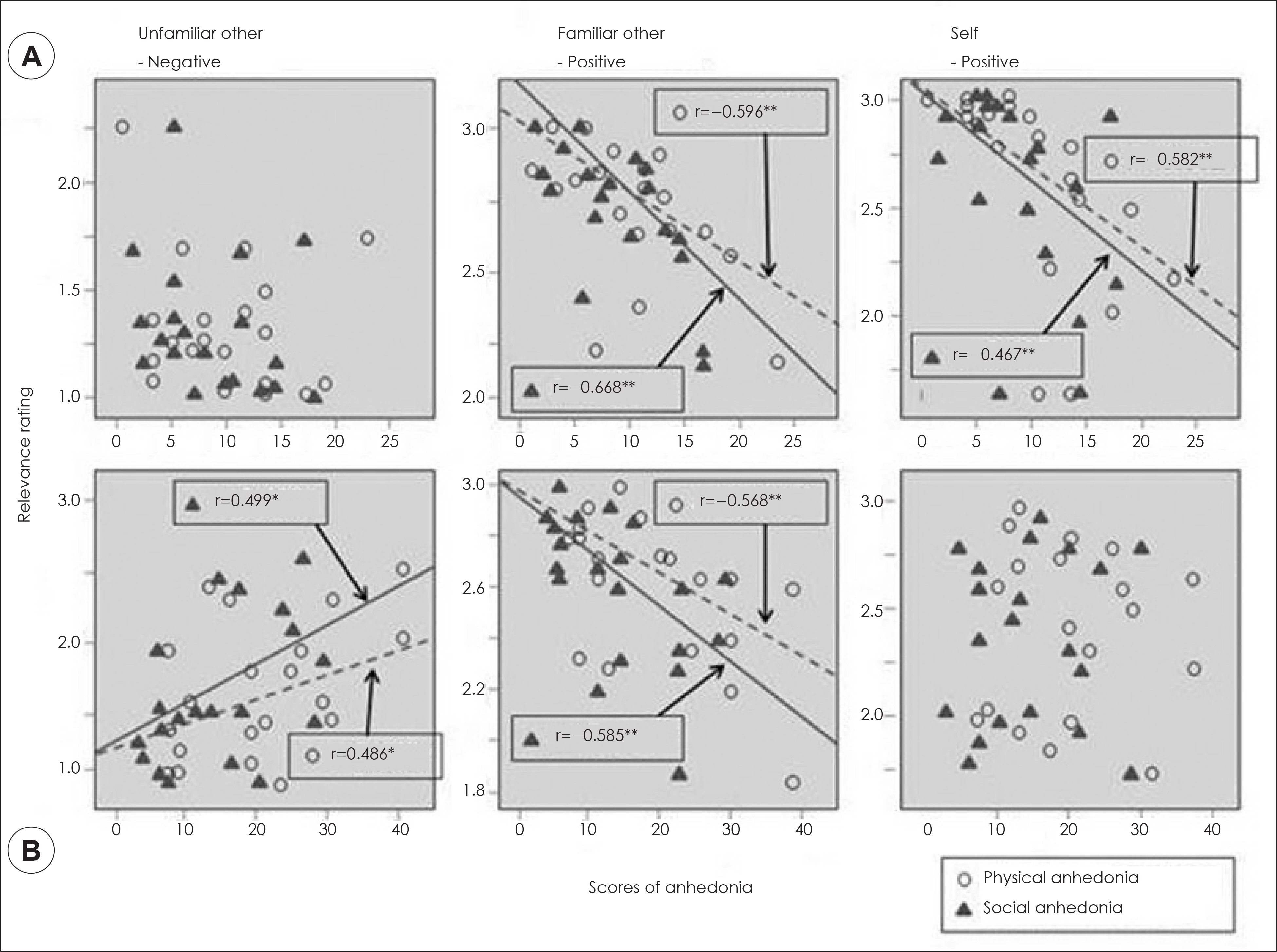Korean J Schizophr Res.
2014 Apr;17(1):36-42. 10.16946/kjsr.2014.17.1.36.
Relationship between Evaluation for the Self and others and Anhedonia in Patients with Schizophrenia
- Affiliations
-
- 1Department of Psychiatry, Yonsei University College of Medicine, Seoul, Korea. jaejkim@yonsei.ac.kr
- 2Institute of Behavioral Science in Medicine, Yonsei University College of Medicine, Seoul, Korea.
- 3Department of Psychiatry, Bundang Jesaeng Hospital, Seongnam, Korea.
- 4Graduate School of Education, Yonsei University, Seoul, Korea.
- 5Department of Communication, Yonsei University, Seoul, Korea.
- KMID: 2288297
- DOI: http://doi.org/10.16946/kjsr.2014.17.1.36
Abstract
OBJECTIVES
The dysfunctional neural networks underlying self-evaluation in schizophrenia are overlapped with the neural structures involved in emotion regulation. The purpose of this study was to investigate the influence of anhedonia on the self-evaluation attitude of patients with schizophrenia.
METHODS
Twenty healthy controls and twenty patients with schizophrenia performed a self-evaluation task, presenting a pair of the face (self, familiar other, and unfamiliar other) and word (negative, neutral, and positive noun) at the same time. Participants were asked to evaluate relevance between the pairs by pressing a corresponding button. Relevance rating scores were compared between the groups and were correlated with the severity of physical and social anhedonia.
RESULTS
Patients evaluated the condition of a self face with a negative word and a familiar face with a negative word to be more relevant than healthy controls. In the patient group, the scores of relevance rating in the condition of an unfamiliar other face with a negative word were positively correlated with the anhedonia scale scores (physical : r=0.486, p=0.030 ; social : r=0.499, p=0.025). There was no correlation between the self-evaluation attitude and the severity of anhedonia.
CONCLUSION
Patients with schizophrenia evaluate themselves badly in only negative circumstances, and anhedonia is not related to self-evaluation, but rather other-evaluation.
Keyword
Figure
Cited by 1 articles
-
Relationship Between Self-Referential Processing and Intrinsic Motivation in Patients with Schizophrenia
Jung Suk Lee, Eun Seong Kim, Eun Joo Kim, Joohan Kim, Jae-Jin Kim
Korean J Schizophr Res. 2015;18(2):73-78. doi: 10.16946/kjsr.2015.18.2.73.
Reference
-
References
1. Silverstone PH. Low self-esteem in different psychiatric conditions. Br J Clin Psychol. 1991; 30:185–188.
Article2. Northoff G, Heinzel A, de Greck M, Bermpohl F, Dobrowolny H, Panksepp J. Self-referential processing in our brain–a metaanalysis of imaging studies on the self. Neuroimage. 2006; 31:440–457.
Article3. Bedford NJ, Surguladze S, Giampietro V, Brammer MJ, David AS. Self-evaluation in schizophrenia: an fMRI study with implications for the understanding of insight. BMC Psychiatry. 2012; 12:106.
Article4. Fossati P, Hevenor SJ, Graham SJ, Grady C, Keightley ML, Craik F, et al. In search of the emotional self: an fMRI study using positive and negative emotional words. Am J Psychiatry. 2003; 160:1938–1945.
Article5. Johnson SC, Baxter LC, Wilder LS, Pipe JG, Heiserman JE, Prigata-no GP. Neural correlates of self-reflection. Brain. 2002; 125:1808–1814.
Article6. Northoff G, Bermpohl F. Cortical midline structures and the self. Trends Cogn Sci. 2004; 8:102–107.
Article7. Ochsner KN, Beer JS, Robertson ER, Cooper JC, Gabrieli JD, Ki-hsltrom JF, et al. The neural correlates of direct and reflected self-knowledge. Neuroimage. 2005; 28:797–814.
Article8. Schmitz TW, Kawahara-Baccus TN, Johnson SC. Metacognitive evaluation, self-relevance, and the right prefrontal cortex. Neuroimage. 2004; 22:941–947.
Article9. Pauly KD, Kircher TT, Schneider F, Habel U. Me, myself and I: temporal dysfunctions during self-evaluation in patients with schizophrenia. Soc Cogn Affect Neurosci;2013.10. Barrowclough C, Tarrier N, Humphreys L, Ward J, Gregg L, Andrews B. Self-esteem in schizophrenia: relationships between self-evaluation, family attitudes, and symptomatology. J Abnorm Psychol. 2003; 112:92–99.
Article11. Holt DJ, Cassidy BS, Andrews-Hanna JR, Lee SM, Coombs G, Goff DC, et al. An anterior-to-posterior shift in midline cortical activity in schizophrenia during self-reflection. Biol Psychiatry. 2011; 69:415–423.
Article12. Blackwood NJ, Bentall RP, Ffytche DH, Simmons A, Murray RM, Howard RJ. Persecutory delusions and the determination of self-relevance: an fMRI investigation. Psychol Med. 2004; 34:591–596.
Article13. Cohen AS, Najolia GM, Brown LA, Minor KS. The state-trait disjunction of anhedonia in schizophrenia: potential affective, cognitive and social-based mechanisms. Clin Psychol Rev. 2011; 31:440–448.
Article14. Barch DM, Sheline YI, Csernansky JG, Snyder AZ. Working memory and prefrontal cortex dysfunction: specificity to schizophrenia compared with major depression. Biol Psychiatry. 2003; 53:376–384.
Article15. Heckers S, Weiss AP, Deckersbach T, Goff DC, Morecraft RJ, Bush G. Anterior cingulate cortex activation during cognitive interference in schizophrenia. Am J Psychiatry. 2004; 161:707–715.
Article16. Taylor SF, Phan KL, Britton JC, Liberzon I. Neural response to emotional salience in schizophrenia. Neuropsychopharmacology. 2005; 30:984–995.
Article17. Park IH, Kim JJ, Chun J, Jung YC, Seok JH, Park HJ, et al. Medial prefrontal default-mode hypoactivity affecting trait physical anhedonia in schizophrenia. Psychiatry Res. 2009; 171:155–165.
Article18. Association AP D-IA. Diagnostic and statistical manual of mental disorders: DSM-IV-TR:. Americal Psychiatric Publishing, Inc;2000.19. Park JY, Oh JM, Kim SY, Lee MK, Lee CR, Kim BR, et al. Korean Facial Expressions of Emotion (KOFEE). Seoul, Korea: Section of Affect & Neuroscience, Institute of Behavioral Science in Medicine, Yonsei University College of Medicine;2011.20. Chapman LJ, Chapman JP, Raulin ML. Scales for physical and social anhedonia. J Abnorm Psychol. 1976; 85:374–382.
Article21. Watson D, Clark LA, Tellegen A. Development and validation of brief measures of positive and negative affect: the PANAS scales. J Pers Soc Psychol. 1988; 54:1063–1070.
Article22. Kay SR, Fiszbein A, Opler LA. The positive and negative syndrome scale (PANSS) for schizophrenia. Schizophr Bull. 1987; 13:261–276.
Article23. Cohen AS, Minor KS. Emotional experience in patients with schizophrenia revisited: metaanalysis of laboratory studies. Schizophr Bull. 2010; 36:143–150.
Article
- Full Text Links
- Actions
-
Cited
- CITED
-
- Close
- Share
- Similar articles
-
- Factors associated with Empathy in Patients with Schizophrenia in Psychiatric Rehabilitation Centers
- A case of atrophy of bilateral frontal lobe which showed negative symptoms of schizophrenia
- The Reliability and Validity of the Korean Version of Apathy Evaluation Scale and its Application in Patients with Schizophrenia
- Influence of Anhedonia and Self-Esteem on Daily-Life Decision-Making in Patients with Schizophrenia
- The Effect of Anhedonia on Suicidal Ideation: The Moderated Mediation Effect of Emotional Intelligence Through Loneliness



